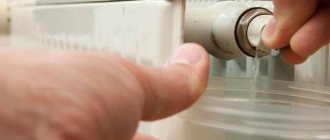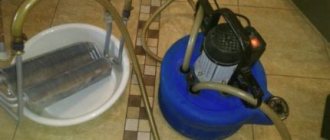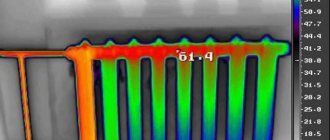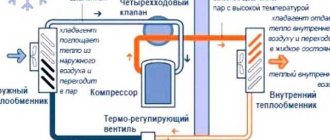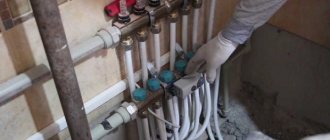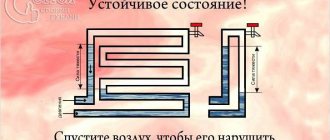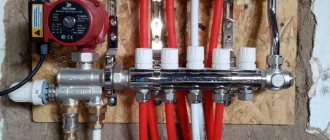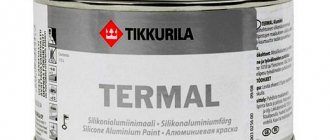Why does air accumulate in water heating radiators?
There are no questions about the appearance of air inside radiators when the heating elements have just been installed new or have undergone major repairs. It is more difficult to find out where the air pockets come from during intensive use of the system. The reason for this is often installation or operating errors.
If we cover all cases of a problem, then air appears in the heating for the following reasons:
- the gravity system does not have a pipe slope;
- the battery is not positioned on the brackets at a strictly horizontal level;
- Filling of water into the heating system was performed incorrectly;
- depressurization of components, poor connection of some heating elements;
- lack of automatic air bleeding or its breakdown;
- carrying out minor repairs to a separate unit, resulting in depressurization of the system;
- accumulation of a large amount of rust inside the battery sections;
- Filling the autonomous heating with a new portion of water containing a large admixture of air.
Violation of the horizontal position of the battery will lead to its frequent airing.
It is difficult to find out why air appeared inside the battery. However, knowing them, it is worth taking measures in advance aimed at reducing the likelihood of heating heating.
Bottom Filling with Administrator Access - Air Lock Removal
It’s one thing if the problem can only be solved from your own apartment or by contacting specialists. It’s another matter if you can play the role of a specialist yourself, for example, by gaining access to the basement.
The solution to the problem in this case is as follows:
- Before removing air from the heating system, it must be bypassed, for which the heating valve is first closed and the sewer discharge located underneath is opened;
- After completing the previous steps, the system should be given about 5-10 minutes to release air;
- If the desired effect is not achieved, the system must be turned in the opposite direction;
- After bleeding the air, you need to close the vent and return all valves to their original positions so that the heating circuit continues to function as normal.
Individual risers with which problems have arisen can also be transferred from the basement level. To do this, it is enough to close the valve of one of the connected risers and open the discharge. The probability of successful bleeding of air in this case is quite high, and if one of the risers is used as an idle pipe, then the work will certainly be crowned with success.
Even if plugs are installed on the risers instead of vents, there are a couple of ways to get rid of an air lock in the heating system:
- The first option is to shut off both risers, reset them, and then replace one of the plugs with a ball valve with a male-female thread. Of course, this option will require the faucet itself - but its cost is low, and such costs are certainly worth it so that the heating system can continue to operate.
- For the second option, you need to close the valves located on the risers, and then unscrew one plug. The riser is put into reset mode, stops, and then the previous operations are repeated in reverse order. This method of bleeding air can only be used when the coolant temperature is below 45 degrees - otherwise the person performing this work may be seriously burned.
How to understand that the battery is airy
Signs of air locks appear immediately. Here you don’t need to be a great specialist to understand that it is necessary to get rid of air in the heating radiator by bleeding it.
Cold areas of the battery indicate the presence of air.
You can recognize the airing of the heating by the following signs:
- Air serves as a kind of heat insulator. In the place where it accumulates inside the battery, the sections are not heated by the coolant. The areas can be easily identified by touching the radiator with the palm of your hand.
- The presence of air will be indicated by gurgling in the radiators when the heating is on.
- Autonomous heating of a closed type is equipped with a pressure gauge. If the measuring device shows a drop in pressure in the system, then it does not occur without a special reason. Probably, a leak appeared somewhere due to depressurization of the unit. Naturally, as the coolant flows out, air penetrates into the system.
If one of the reasons appears, you need to bleed the air from the radiator in the apartment, after which the heating will be restored.
Important! The reason for the battery cooling may be that one of the supply pipes is clogged with rust or dirt. If, when draining from the Mayevsky tap, a strong stream of water flows without pops of air, then the problem is not airing.
Bleeding air from radiators
The formation of air pockets can occur even if not the entire system has been drained, but only a separate section of it, for example, a radiator. In this case, refilling with water should be carried out in the following sequence:
- Loosen the top inlet fitting or open the drain valve to allow air to escape unobstructed.
- Open the bottom tap and feed the radiator until the escaping air is replaced by water.
- Pack the top fitting and open the top supply valve.
In addition, all radiators of closed systems, as well as systems with bottom wiring, must be equipped with Mayevsky taps. It is through them that the main volume of air is vented during refueling, since the upper outlet of the radiator is nothing more than the highest point of such a system.
Please note that aluminum radiators can, in some special cases, serve as a source of gas for plugs. The fact is that with a high content of dissolved ions in water and the presence of electrical emission, aluminum quickly corrodes, releasing hydrogen in a significant volume
If you are faced with an indirect source of gas formation, exclude any contact of electrical equipment with the system and ground its metal parts.
When to bleed batteries
Bleeding the air should be done immediately as soon as one of the listed reasons appears. However, they can only be identified during the season when the heating is on.
Airing is easy to detect during heating operation
It is important to know that air is generated inside the system even when it is not operating. Many people do not pay attention to this nuance, but in vain. Oxygen inside the battery and metal pipes promotes corrosion. Pieces of rust fall off and clogs form. To extend the life of the system, the air in the heating radiators in the apartment is bleed even in summer.
During this period, airing most often occurs for the following reasons:
- The summer period is reserved for heating repairs. Plumbers from a service organization change valves and rotten pipes. To repair a separate area, water is drained from the entire riser.
- In the summer, apartment owners independently repair their heating. Due to the inability to disconnect the circuit from the centralized system, water is similarly discharged from the entire riser. In some cases, they drain from the entire multi-story building.
- If the shut-off valves at the entrance to an apartment building were closed, according to the laws of physics, the volume of coolant decreased. After opening the valves, water supplied under pressure sucks in air and fills the risers with it.
- Often in the summer, mechanics deliberately relieve pressure from risers in order to avoid unnecessary work in the future. The fact is that old cast-iron batteries, after stopping the heating, sometimes begin to leak at the junctions of the sections if they stand for a long time under high pressure of the cold coolant. It is easier for mechanics to relieve pressure than to change many gaskets while performing complex disassembly of sections.
To ventilate the entire riser, you need to bleed the air from the radiator on the top floor or attic, which depends on the heating scheme. This work is usually carried out by the mechanics themselves before the start of the heating season. The owner of each apartment attached to this riser must periodically bleed air from his radiators in the summer so that his own system remains filled with coolant to the maximum.
Algorithm for cleaning the radiator
- We remove all unnecessary things and furniture from the heating radiator that may interfere with or delay flushing. If there are curtains hanging near it, you need to remove them. In addition, if the room uses laminate or parquet as flooring, then it is necessary to spread some piece of fabric or film under the radiator - this is done so as not to harm the floor.
Before starting work, you must turn off all taps
It is necessary to shut off the water supply to the radiator. If there is no shut-off valve that allows this to be done, then you will have to go the other way - drain the water from the heating system. Take a regular bucket, remove the radiator by unscrewing it from the rest of the equipment, and drain the water present in it into the prepared bucket. The cleaning process is just beginning and then you need to take the heating radiator to the bathroom and then place it in the bathtub. There is a risk of causing mechanical damage to it in the form of scratches, and in order to prevent such a development of events, place something like a wooden pallet under the radiator. If you live in a private house and not in an apartment, then to flush the radiator you will need to take it out into the yard.
The end fittings are unscrewed using a wrench
We unscrew the end fittings using a wrench. This must be done in the yard or in the bathroom, otherwise you can fill the floor with a cloudy and littered liquid that has a very unpleasant odor, and you will create another problem for yourself - you will need to clean the floor.
We recommend: What is isolon, technical characteristics of insulation and its types
Next, you need to rinse the heating radiator from the inside; to do this, we supply water under pressure from a hose or shower into the holes at the end.
- Sometimes owners are forced to deal with crystalline blockages, and in this case slightly different means are needed. You can't do without a concentrated vinegar solution. We install the end fittings at the bottom and pour vinegar inside. Before using vinegar, it is recommended to dilute it 70% with water. This flushing will help remove stubborn blockages from the heating radiator. The solution should sit for about two hours, after which it should be poured out and the radiator should be cleaned with water pressure to achieve complete cleansing.
- You can also wash the external surfaces of the radiator to give it a nice and clean look.
One of the reasons for clogging may be scale formation
The radiator should be placed on wall mounts and the threaded connections on it should be lightly cleaned with a cloth, which must be dry. If you have a cast iron radiator, then screw tow onto all the fittings in the direction of the threads and apply paint to the seal. It is allowed to use any paint related to “Nitro” and “Enamel”. Using a two-piece gas wrench, tighten the fittings tightly. If the apartment has more modern radiators, then it is recommended to use film for waterproofing purposes. Do not use tow or paint.
So, as we see, there is nothing overly complicated about cleaning the radiator. This will not require any special skills or knowledge, just as you will not need any rare means and tools that are difficult to obtain. If done responsibly, this procedure will not take too much time and effort, and therefore every owner can clean the radiator on their own. However, there are situations where even after all the measures have been taken and the radiators are installed in their place, the heating system still functions poorly. In this case, you need to buy a new radiator and replace the old one, or use the services of specialized companies that carry out cleaning with a technical booster.
How to bleed air from radiators
Special units have been created to remove air pockets. They work in manual or automatic mode, depending on the device. Such fittings should be installed on every radiator and complex sections of the pipeline.
How to bleed air from a battery through a tap
The simplest and most common unit for venting heating is the Mayevsky tap. Install it on one of the top battery plugs.
The Mayevsky valve is the most common unit for bleeding air from batteries
Important! In order to bleed air from the old-style battery, in the past, instead of Mayevsky taps, ordinary bronze water taps used on washstands were often installed. The essence of the de-airing procedure does not change depending on the design of the unit.
If we talk about Mayevsky cranes, they also have many varieties. Outdated models are designed for a screwdriver or wrench. On the one hand, this has a plus. Unqualified people or children will not open the tap on their own, which will prevent flooding of the apartment. On the other hand, maintenance inconveniences are created. To unscrew the tap, you need to have a tool with you. Sometimes it may boil with solid deposits. Excessive force with the tool leads to breakage of the working rod.
Modern Mayevsky taps are equipped with removable handles. The bleed hole is located on the side, which makes it possible to conveniently drain the coolant into a substitute container.
To use the Mayevsky tap to bleed air from the battery, you need to perform the following steps:
- The area of the battery near the tap is wrapped in rags. It will prevent water from splashing around the room. Place a container under the drain hole.
- The valve stem is slowly unscrewed using a tool or handle until air hisses. If the mechanism is stuck, you should not try to force it off. They try to gently loosen the rod by lightly pressing in different directions.
- When air hisses from the hole, wait for a steady stream of water to appear. Drain to about 2 liters.
- Turn on the tap and wait about 10 minutes. The process is repeated to make sure there is no air.
After the procedure, the tap is checked for leaks. It is better to remove the removable handle so that children do not get to it.
How to bleed air from a battery without a tap
The absence of a valve to bleed air complicates heating maintenance. However, in some cases it is not needed. The first example is heating with automatic air vents. The unit is designed in such a way that it independently removes air from the system. The owner of the apartment only needs to periodically make sure that the air vent is working.
The second example is an open-type autonomous heating system. The system requires an expansion tank for water. It is installed at the highest point of the working circuit. All air will escape through the tank. The only important thing is the constant presence of a small level of water in it. If the owner misses, the heating will “air up” through the empty expansion tank. To expel the air, just add water to the system. However, filling is carried out through a fitting installed at the lowest point of the circuit. This is usually the return pipe entry to the boiler.
In an autonomous closed-type system, it is impossible to bleed air through the expansion tank, since it is replaced by a hydraulic accumulator. It is impossible to do air deflation if there are no automatic vents and taps. In this case, you will have to resort to a radical method - partially unscrewing the side radiator cap.
Attention! Partially unscrewing the radiator cap to remove air is only possible in autonomous heating of your own home with low coolant pressure.
To bleed air through the battery plug, you will need a gas wrench.
The danger of the method is due to flooding of the room. For this reason, it cannot be used in apartments. Firstly, central heating works under high pressure. If the plug has a bad thread, it will immediately rip out of the battery when you try to unscrew it. Secondly, not only your own premises will suffer in the apartment, but also the neighbors located on the floors below.
The owner of his own home can use this method at his own risk. To ventilate, unscrew one of the top plugs of the battery, to which the pipeline is not connected, a couple of turns. That is, it plays the role of a stub. The plug can be with left or right thread. Most often, the plugs on cast iron radiators are left-handed, but it is better to make sure by turning them slightly in different directions.
After unscrewing the plug a couple of turns with a gas wrench, air hisses. Before this, you need to lay a film under the battery, prepare rags and buckets to collect water. Over time, the air will partially escape with splashes. When the hissing stops completely and water begins to drip, the plug is tightened by winding several turns of flax or fum tape.
Device for removing air from radiators
To facilitate air outlet, an additional hole was made perpendicular to the main channel. The air actually comes out through it. When deflating using a Mayevsky tap, point this hole upward. After this you can unscrew the screw. Unscrew it a few turns, but do not unscrew it too much. After the hissing stops, return the screw to its original position and move on to the next radiator.
When starting the system, it may be necessary to bypass all the air collectors several times until air stops escaping altogether. After this, the radiators should heat up evenly.
Automatic air release valve
These small devices are installed both on radiators and at other points in the system. They differ in that they allow you to bleed air in the heating system automatically. To understand the principle of operation, consider the structure of one of the automatic air valves.
The operating principle of the automatic release is as follows:
- In normal condition, the coolant fills the chamber by 70 percent. The float is at the top, pressing the rod.
- When air enters the chamber, the coolant is forced out of the housing and the float lowers.
- He presses the protrusion-flag on the nozzle, squeezing it out.
- The depressed jet opens a small gap, which is enough to allow the air that has accumulated in the upper part of the chamber to escape.
- As water comes out, the air vent body fills with water.
- The float rises, releasing the rod. It returns to its place due to the spring.
Various designs of automatic air valves operate on this principle. They can be straight or angular. They are placed at the highest points of the system and are present in the security group. They can be installed in identified problem areas - where the pipeline has an incorrect slope, which is why air accumulates there.
Instead of Mayevsky's manual taps, you can install an automatic drain for radiators. It is only slightly larger in size, but works automatically.
How long do you need to bleed the batteries?
The duration of the procedure is determined individually. It all depends on the scheme, type of heating, degree of airing. Usually the process is considered complete when the air stops hissing from the tap and the water flows in a steady stream.
The deaeration process is considered complete when water flows steadily from the tap.
To confidently remove the air lock in the heating battery, drain 3 buckets of water through the tap. With this amount of coolant, all the air is guaranteed to escape.
Harmful air in the heating system
First of all, it is necessary to understand what danger the air that gets into it poses to the heating system. But the problem is quite simple - air locks in the heating system completely paralyze the operation of the heating system along its entire length or in a separate area.
It's all about a small pressure difference at the inlet and outlet of the system - this value usually does not exceed 0.2 kgf/cm. This pressure is not enough to level out the difference in the density of water and air. Because of this, the upper part of the riser is completely filled with air, and the coolant simply cannot circulate. As a result, apartments are left without heating, and when cold weather sets in, a section of the system completely freezes.
The problems do not end with the phenomena described above. In multi-storey buildings built back in Soviet times, pipes made of ordinary steel are still used. The humidity in the heating system is high, and black steel in such conditions, upon contact with air, begins to deteriorate at a manifold accelerated rate. The result is predictable - at some point the system becomes completely inoperable. To prevent this from happening, you will have to figure out how to bleed air from the heating system.
How to avoid air locks
It is impossible to completely 100% eliminate the formation of air locks even in modern heating. But you can reduce the likelihood of their formation if you follow a number of rules.
When heating is installed according to the correct design, airing rarely occurs
First of all, you need to correctly install all heating devices and select the optimal heating scheme for a particular building. The batteries are placed strictly horizontally. The pipeline is laid with slopes. Each radiator is equipped with a Mayevsky valve or automatic air vents are installed. Moreover, the unit is additionally installed in difficult sections of the pipeline, where there is a risk of plug formation.
Water is added to the autonomous system through the return line. To do this, a fitting with a shut-off device is provided at the bottom point of the circuit. If the autonomous system is of an open type, the water level in the expansion tank is constantly maintained.
The provided video will help you bleed air from the heating radiator:
Advice from professionals
A few tips from professionals will help you safely ventilate the system and reduce the likelihood of blockages:
- Always add water to the cooled autonomous heating circuit from the lowest point under low pressure. After topping up, turn on the boiler, heat the coolant to a temperature of 60 °C, and begin to bleed air from each battery through the Mayevsky valve. If necessary, after servicing all radiators, add more water to the system.
- The rod from the Mayevsky tap cannot be completely unscrewed. It is difficult and often impossible to screw it back in under running hot water.
- Unscrewing the radiator cap in an apartment is strictly prohibited. Central heating operates under high pressure. If the plug is torn off, all the apartments below will be flooded.
If problems arise with airing, it is best to call a specialist from a service organization who has the right to turn off the riser for repairs even during the heating season.
